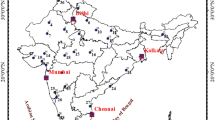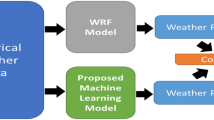Abstract
The availability of accurate solar radiation data is essential for designing as well as simulating the solar energy systems. In this study, by employing the long-term daily measured solar data, a neural network auto-regressive model with exogenous inputs (NN-ARX) is applied to predict daily horizontal global solar radiation using day of the year as the sole input. The prime aim is to provide a convenient and precise way for rapid daily global solar radiation prediction, for the stations and their immediate surroundings with such an observation, without utilizing any meteorological-based inputs. To fulfill this, seven Iranian cities with different geographical locations and solar radiation characteristics are considered as case studies. The performance of NN-ARX is compared against the adaptive neuro-fuzzy inference system (ANFIS). The achieved results prove that day of the year-based prediction of daily global solar radiation by both NN-ARX and ANFIS models would be highly feasible owing to the accurate predictions attained. Nevertheless, the statistical analysis indicates the superiority of NN-ARX over ANFIS. In fact, the NN-ARX model represents high potential to follow the measured data favorably for all cities. For the considered cities, the attained statistical indicators of mean absolute bias error, root mean square error, and coefficient of determination for the NN-ARX models are in the ranges of 0.44–0.61 kWh/m2, 0.50–0.71 kWh/m2, and 0.78–0.91, respectively.




Similar content being viewed by others
Change history
09 March 2020
The Editor-in-Chief has retracted this article [1] because validity of the content of this article cannot be verified. This article showed evidence of substantial text overlap (most notably with the articles cited [2, 3]) and authorship manipulation.
References
Abdalla YAG (1994) New correlation of global solar radiation with meteorological parameters for Bahrain. Int J Sol Energy 16:111–120
Al-Salaymeh A (2006) Model for the prediction of global daily solar radiation on horizontal surfaces for Amman city. Emirates J Eng Res 11(1):49–56
Bakirci K (2009) Correlations for estimation of daily global solar radiation with hours of bright sunshine in Turkey. Energy 34:485–501
Bahel V, Bakhsh H, Srinivasan R (1987) A correlation for estimation of global solar radiation. Energy 12:131–135
Bannani FK, Sharif TA, Ben-Khalifa AOR (2006) Estimation of monthly average solar radiation in Libya. Theor Appl Climatol 83:211–215
Benghanem M, Mellit A (2014) A simplified calibrated model for estimating daily global solar radiation in Madinah, Saudi Arabia. Theor Appl Climatol 115:197–205
Bosch JL, Lopez G, Batlles FJ (2008) Daily solar irradiation estimation over a mountainous area using artificial neural networks. Renew Energy 33:1622–1628
Bulut H, Büyükalaca O (2007) Simple model for the generation of daily global solar radiation data in Turkey. Appl Energy 84(5):477–491
Chen JL, Li GS (2014) Evaluation of support vector machine for estimation of solar radiation from measured meteorological variables. Theor Appl Climatol 115:627–638
Dahmani K, Dizene R, Notton G, Paoli C, Voyant C, Nivet ML (2014) Estimation of 5-min time-step data of tilted solar global irradiation using ANN (artificial neural network) model. Energy 70:374–381
Duzen H, Aydin H (2012) Sunshine-based estimation of global solar radiation on horizontal surface at Lake Van region (Turkey). Energy Convers Manag 58:35–46
Elagib AA, Mansell MG (2000) New approaches for estimating global solar radiation across Sudan. Energy Convers Manag 41:419–434
El-Sebaii AA, Al-Hazmi FS, Al-Ghamdi AA, Yaghmour SJ (2010) Global, direct and diffuse solar radiation on horizontal and tilted surfaces in Jeddah, Saudi Arabia. Appl Energy 87:568–576
Güçlü YS, Yelegen MÖ, Dabanlı İ, Şişman E (2014) Solar irradiation estimations and comparisons by ANFIS, Angstrӧm-Prescott and dependency models. Sol Energy 109:118–124
Izady A, Davary K, Alizadeh A, Moghaddam Nia A, Ziaei AN, Hasheminia SM (2013) Application of NN-ARX model to predict groundwater levels in the Neishaboor Plain, Iran. Water Resour Manag 27:4773–4794
Izgi E, Öztopal A, Yerli B, Kaymak MK, Şahin AD (2012) Short–mid-term solar power prediction by using artificial neural networks. Sol Energy 86:725–733
Jang JSR (1993) ANFIS: adaptive-network-based fuzzy inference systems. IEEE Trans Syst Man Cybern 23:665–685
Jang JSR, Sun CT (1995) Neuro-fuzzy modeling and control. Proc IEEE 83:378–406
Kaplanis S, Kaplani E (2007) A model to predict expected mean and stochastic hourly global solar radiation I(h;nj) values. Renew Energy 32(8):1414–1425
Keshavarz E, Roopaei M (2006) Intelligent structures in economical forecasting. In: Proceedings of the International Conference on Advanced Technologies in Telecommunications and Control Engineering (ATTCE)
Khorasanizadeh H, Mohammadi K (2013) Prediction of daily global solar radiation by day of the year in four cities located in the sunny regions of Iran. Energy Convers Manag 76:385–392
Khorasanizadeh H, Mohammadi K, Jalilvand M (2014) A statistical comparative study to demonstrate the merit of day of the year-based models for estimation of horizontal global solar radiation. Energy Convers Manag 87:37–47
Koca A, Oztop HF, Varol Y, Koca GO (2011) Estimation of solar radiation using artificial neural networks with different input parameters for Mediterranean region of Anatolia in Turkey. Expert Syst Appl 38:8756–62
Li H, Ma W, Lian Y, Wang X (2010) Estimating daily global solar radiation by day of year in China. Appl Energy 87:3011–3017
Linares-Rodriguez A, Ruiz-Arias JA, Pozo-Vazquez D, Tovar-Pescador J (2013) An artificial neural network ensemble model for estimating global solar radiation from Meteosat satellite images. Energy 61:636–645
Ljung L (1999) System identification. Theory for the user. Prentice-Hall PTR, Englewood Cliffs
Mellit A, Hadjarab A, Khorissi N, Salhi H (2007) An ANFIS-based forecasting for solar radiation data from sunshine duration and ambient temperature. Power Eng Soc Gen Meet IEEE. doi:10.1109/PES.2007.386131 1–6
Mohammadi K, Khorasanizadeh H (2015) A review of solar radiation on vertically mounted solar surfaces and proper azimuth angles in six Iranian major cities. Renew Sustain Energy Rev 47:504–518
Mohammadi K, Shamshirband S, Anisi MH, Alam KA, Petkovic D (2015a) Support vector regression based prediction of global solar radiation on a horizontal surface. Energy Convers Manag 91:433–441
Mohammadi K, Shamshirband S, Seyed Danesh A, Abdullah MS, Zamani M (2015b) Temperature-based estimation of global solar radiation using soft computing methodologies. Theor Appl Climatol. doi:10.1007/s00704-015-1487-x
Mohammadi K, Shamshirband S, Tong CW, Alam KA, Petkovic D (2015c) Potential of adaptive neuro-fuzzy system for prediction of daily global solar radiation by day of the year. Energy Convers Manage 93:406–413
Mohandes MA (2012) Modeling global solar radiation using particle swarm optimization (PSO). Sol Energy 86:3137–3145
Mohanty S (2014) ANFIS based prediction of monthly average global solar radiation over Bhubaneswar (State of Odisha). Int J Ethics Eng Manage Educ ISSN: 2348-4748, 1.
Mohanty S, Patra PK, Sahoo SS (2015) Comparison and prediction of monthly average solar radiation data using soft computing approach for eastern India. Computational intelligence in data mining—volume 3. Smart Innov Syst Technol 33:317–326
Mubiru J, Banda EJKB, D’Ujanga F, Senyonga T (2007) Assessing the performance of global solar radiation empirical formulations in Kampala, Uganda. Theor Appl Climatol 87:179–184
Muzathik AM, Ibrahim MZ, Samo KB, Wan Nik WB (2011) Estimation of global solar irradiation on horizontal and inclined surfaces based on the horizontal measurements. Energy 36:812–818
Ododo JC, Sulaiman AT, Aidan J, Yguda MM, Ogbu FA (1995) The importance of maximum air temperature in the parameterization of solar radiation in Nigeria. Renew Energy 6:751–763
Ojosu JO, Komolafe LK (1987) Models for estimating solar radiation availability in South Western Nigeria. Niger J Solar Energy 6:69–77
Ozgoren M, Bilgili M, Sahin B (2012) Estimation of global solar radiation using ANN over Turkey. Expert Syst Appl 39:5043–5051
Piri J, Amin S, Moghaddamnia A, Han D, Remesun D (2009) Daily pan evaporation modelling is hot and dry climate. J Hydrol Eng 14:803–811
Rahimikhoob A (2010) Estimating global solar radiation using artificial neural network and air temperature data in a semi-arid environment. Renew Energy 35:2131–2135
Rizwan M, Jamil M, Kirmani S, Kothari DP (2014) Fuzzy logic based modeling and estimation of global solar energy using meteorological parameters. Energy 70:685–691
Sabziparvar AA (2007) General formula for estimation of monthly mean global solar radiation in different climates on the south and north coasts of Iran. Int J Photo Energy. doi:10.1155/2007/94786
Shamim MA, Bray M, Remesan R, Han D (2015) A hybrid modelling approach for assessing solar radiation. Theor Appl Climatol. doi:10.1007/s00704-014-1301-1
Trabea AA, Shaltout MAM (2000) Correlation of global solar radiation with meteorological parameters over Egypt. Renew Energy 21:297–308
Wu Z, Du H, Zhao D, Li M, Meng X, Zong S (2012) Estimating daily global solar radiation during the growing season in northeast China using the Ångström–Prescott model. Theor Appl Climatol 108:495–503
Zang H, Xu Q, Bian H (2012) Generation of typical solar radiation data for different climates of China. Energy 38:236–248
Author information
Authors and Affiliations
Corresponding author
Additional information
The Editor-in-Chief has retracted this article because validity of the content of this article cannot be verified. This article showed evidence of substantial text overlap (most notably with two articles; see retraction note for details) and authorship manipulation. Shahaboddin Shamshirband disagrees with this retraction. Authors Abdullah Gani Kasra Mohammadi, Hossein Khorasanizadeh, Amir Seyed Danesh, Jamshid Piri, Zuraini Ismail, Mazdak Zamani have not responded to correspondence about this retraction.
About this article
Cite this article
Gani, A., Mohammadi, K., Shamshirband, S. et al. RETRACTED ARTICLE: Day of the year-based prediction of horizontal global solar radiation by a neural network auto-regressive model. Theor Appl Climatol 125, 679–689 (2016). https://doi.org/10.1007/s00704-015-1533-8
Received:
Accepted:
Published:
Issue Date:
DOI: https://doi.org/10.1007/s00704-015-1533-8




